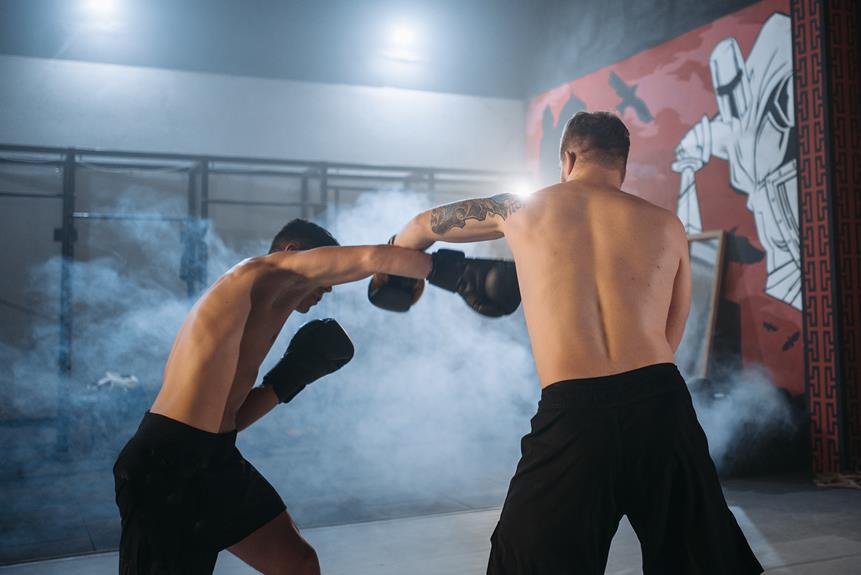In the realm of combat sports, the casting punch has emerged as a captivating technique, captivating the attention of analysts and enthusiasts alike. This unorthodox strike, characterized by its long-range hooking motion, has proven to be a formidable weapon in both MMA and sambo.
With its unique mechanics and ability to catch opponents off guard, the casting punch has earned the respect of notable fighters such as Fedor Emelianenko, Khabib Nurmagomedov, and Rustam Khabilov.
In this article, we delve into the origins, mechanics, and effectiveness of the casting punch, offering insights for those seeking mastery in MMA and sambo.
Key Takeaways
- A casting punch is an unorthodox long-range hooking punch thrown with a whipping motion, often used in MMA and sambo.
- The casting punch originated in sambo as a strike disguised to initiate a grab or clinch, but is now used as an effective long-range hooking strike in MMA.
- The technique involves throwing the punch with the thumb facing down, the pinky finger facing upward, and the aim is to connect with the index and second knuckle.
- The casting punch can be effective in MMA for its long-range and powerful hook, and can be used to close the distance on an opponent, initiate grappling, and for counterpunching.
Origins and Evolution of the Casting Punch
The casting punch has evolved over time, originating from bare-knuckle boxing in the 17th to 19th century and finding its way into sambo in the 1920s. Bare-knuckle boxing, governed by the Broughton and London Prize Ring Rules, provided the early roots of this technique.
However, when boxing gloves became mandatory under the Queensberry rules, the effectiveness of the casting punch diminished. In sambo, the casting punch was adapted and utilized as a strike disguised to initiate a grab or clinch.
Over the years, the evolution of striking techniques in MMA and sambo has further refined the casting punch, turning it into a powerful long-range hooking strike. With its deceptive nature and ability to catch opponents off guard, the casting punch has become an integral part of the arsenal for fighters like Fedor Emelianenko, Khabib Nurmagomedov, and Rustam Khabilov.
Its effectiveness lies in its versatility, allowing fighters to both close the distance and initiate grappling while maintaining defensive integrity.
Technique and Mechanics of the Casting Punch
The execution of the casting punch in MMA and sambo relies on a precise and coordinated combination of body mechanics and technique. To understand the mechanics breakdown of this technique, consider the following steps:
- Shoulder and Arm Positioning: Start by leading the shoulder forward, which helps generate power. Bring the elbow up to shoulder height, ensuring proper alignment and leverage for the punch.
- Whipping Motion: Whip the arm around towards the opponent, utilizing the full range of motion to generate speed and power. This whipping motion adds an element of surprise and can catch opponents off guard.
- Fist Positioning: As the arm whips around, turn over the fist so that the pinky is up and the thumb is down. This positioning allows for proper alignment of the hand and maximizes the impact surface area. Connect to the intended target with the first two knuckles to maximize effectiveness.
To improve the technique of the casting punch, training drills focused on shoulder and arm positioning, as well as the whipping motion, can be beneficial. These drills can help develop the necessary muscle memory and timing required for the effective execution of the casting punch.
Advantages and Applications of the Casting Punch
Advantages and applications of the casting punch in MMA and sambo include its versatility and effectiveness in various fighting scenarios.
The casting punch offers fighters the ability to strike from a longer range, allowing them to maintain distance and control the fight. This technique can be used to close the distance on an opponent, surprising them with its unorthodox angle of attack.
Additionally, the casting punch can be utilized to initiate grappling, as it can be thrown in a way that disguises the intention to clinch or grab. Furthermore, the casting punch is defensively sound, serving as an effective counterpunching tool. Its whipping motion and deceptive nature catch opponents off guard, making it a valuable technique in a fighter's arsenal.
Variations of the casting punch can be developed based on individual preferences and fighting styles, enhancing its versatility and adaptability in different situations.
Defensive Uses of the Casting Punch
One defensive use of the casting punch in MMA and sambo is its ability to effectively counter an opponent's strikes. By utilizing the casting punch defensively, fighters can strategically time their strikes to disrupt the flow of their opponent's attacks and create openings for their own counterattacks.
Here are three ways in which the casting punch can be used defensively:
- Interrupting the opponent's strikes: The casting punch can be thrown with precision and speed to intercept an opponent's incoming strikes, effectively disrupting their rhythm and preventing them from landing clean shots.
- Creating distance: By utilizing the long-range nature of the casting punch, fighters can keep their opponents at bay and create distance, making it harder for the opponent to engage in close-quarters combat or land powerful strikes.
- Countering with power: The casting punch's whipping motion generates significant power, allowing fighters to deliver strong counterattacks that can deter their opponents from continuing their offensive onslaught.
Sneakiness and Element of Surprise in the Casting Punch
Utilizing its deceptive nature, the casting punch in MMA and sambo can catch opponents off guard, adding an element of sneakiness and surprise to its effectiveness. This unorthodox punch is thrown with a whipping motion, making it difficult for opponents to anticipate.
The unique hand positioning, with the thumb facing down and the pinky finger facing upward, contributes to the element of surprise. As the punch is delivered with a quick and unexpected motion, opponents may be caught off balance, leaving them susceptible to the strike.
The casting punch's sneakiness lies in its ability to disguise its intention, often appearing as a setup for a grab or clinch. When executed with precision and timing, the casting punch can be a valuable tool in a fighter's arsenal, allowing them to capitalize on the element of surprise and gain the upper hand in a fight.
Notable MMA Fighters Who Employ the Casting Punch
Several notable MMA fighters have employed the casting punch in their fights. These fighters have trained extensively in order to master this unorthodox technique. Here are three notable MMA fighters who utilize the casting punch:
- Fedor Emelianenko: Known as 'The Last Emperor,' Emelianenko is a legendary heavyweight fighter who has used the casting punch to great effect. His technique and timing with this strike have allowed him to knock out many of his opponents.
- Khabib Nurmagomedov: The retired UFC lightweight champion is renowned for his dominant grappling skills, but he has also utilized the casting punch in his fights. Nurmagomedov's ability to seamlessly transition from striking to grappling has made him a formidable force in the octagon.
- Rustam Khabilov: Hailing from Dagestan, Khabilov is another fighter who has incorporated the casting punch into his arsenal. His proficiency in sambo, where the casting punch originated, has enabled him to effectively utilize this striking technique against his opponents.
These fighters have dedicated countless hours to training and refining their casting punch technique, allowing them to effectively employ it in their fights.
Casting Punch as a Versatile Technique in MMA/Sambo
The casting punch, known for its effectiveness in MMA and sambo, is a versatile technique that offers fighters a range of tactical options. This technique can be modified and adapted to suit different situations, allowing fighters to employ various casting punch variations to keep their opponents guessing.
One common variation is the lunging casting punch, where the fighter takes a step forward while throwing the punch, increasing the power and momentum behind the strike.
Another variation is the spinning casting punch, where the fighter rotates their body while throwing the punch, catching their opponent off guard with the unexpected angle of attack.
However, like any technique, the casting punch is not without its counters. Opponents can use footwork and head movement to evade the punch, or they can employ defensive techniques such as slipping or parrying to neutralize its effectiveness.
Additionally, fighters can anticipate the casting punch and counter with their own strikes, taking advantage of the opening created by the punch.
Factors Affecting the Effectiveness of the Casting Punch
When considering the effectiveness of the casting punch in MMA and sambo, various factors come into play. Two key factors that greatly affect the effectiveness of the casting punch are timing and accuracy.
Timing: The timing of the casting punch is crucial for its success. It requires the fighter to anticipate the opponent's movements and strike at the opportune moment. A well-timed casting punch can catch the opponent off guard and deliver maximum impact.
Accuracy: The accuracy of the casting punch is essential for targeting vulnerable areas of the opponent's body. It is important to aim for the index and second knuckles to maximize the power and effectiveness of the strike. Precise targeting ensures that the casting punch lands with full force and achieves its intended objective.
Frequently Asked Questions
Are There Any Specific Rules or Regulations Regarding the Use of Casting Punches in MMA or Sambo?
Specific rules and regulations regarding the use of casting punches in MMA or Sambo may vary. However, the importance of proper technique, timing, and accuracy cannot be understated in maximizing the effectiveness of casting punches in these combat sports.
Can the Casting Punch Be Effectively Used Against Taller Opponents?
When facing taller opponents in MMA/Sambo, countering with a casting punch can be effective. Proper footwork is crucial for closing the distance and executing the punch with accuracy. This technique allows for surprising and powerful strikes against taller opponents.
Is the Casting Punch More Commonly Used as a Standalone Strike or as a Setup for Other Techniques?
The casting punch in MMA/Sambo can be used both as a standalone strike and as a setup for other techniques. Its effectiveness lies in its ability to surprise opponents and close the distance, making it a versatile tool in a fighter's arsenal.
Are There Any Known Disadvantages or Limitations to Using the Casting Punch in MMA or Sambo?
There are some disadvantages and limitations to using the casting punch in MMA or sambo. These include the potential for telegraphing the strike, vulnerability to counterattacks, and the need for precise timing and accuracy.
How Does the Casting Punch Compare to Other Striking Techniques in Terms of Power and Effectiveness?
The casting punch in MMA and sambo showcases its power and effectiveness compared to other striking techniques. This unorthodox, long-range hooking punch delivers a surprising blow that catches opponents off guard, making it a valuable asset in a fighter's arsenal.
Conclusion
In conclusion, the casting punch has emerged as a highly effective striking technique in both MMA and sambo. Its origins in sambo as a deceptive move to initiate grappling have evolved into a powerful and unexpected strike.
Notable fighters have successfully utilized the casting punch, showcasing its potential as a valuable addition to a fighter's arsenal. Its ability to cover distance, catch opponents off guard, and initiate grappling make it a versatile and formidable technique in combat sports.
As the adage goes, 'The element of surprise is worth two in the fight.'
- 15 Best Martial Arts Weapons (Fighting & Training) - October 14, 2024
- Is Fencing a Martial Art? (Yes, 4 Reasons Why) - October 14, 2024
- 7 Best Martial Arts for Self-defense Ranked (Highly Effective) - October 14, 2024










